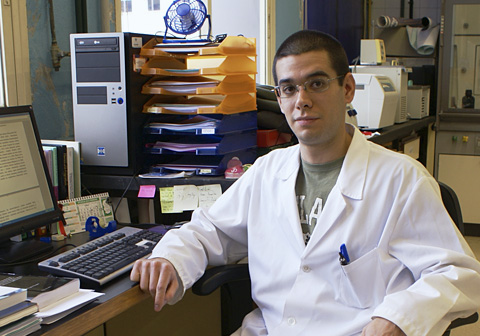Right now, there are 10,000 components that can be used to make cosmetics. These components have to be monitored to guarantee consumer safety. The UPV/EHU researcher Josu López has developed three ‘green' analytical methods to simultaneously analyse various components used in cosmetics. In these methods very little solvent is used and very little residue is produced in comparison with other analytical techniques.
‘Green chemistry' to quantify the components of cosmetics
A UPV/EHU-University of the Basque Country researcher has developed and applied three methods to analyse various compounds in cosmetics
First publication date: 26/05/2015

Cosmetics is an important industry worldwide and has attained high levels of sophistication. There are over 10,000 components that can be used to make cosmetics; so it is essential to monitor these components to guarantee consumer safety. Regulation 1223/2009 approved by the European Union in 2009 established a list of components that guarantee consumer safety as well as certain conditions for using these components, such as maximum concentration and what type of products they can be used in.
In his PhD thesis, the researcher Josu López of the Department of Applied Chemistry of the UPV/EHU's Faculty of Chemistry has developed and applied methods to quantify some of these components. The methods studied by López are based on capillary electrophoresis. As the researcher explained, "one of the most important advantages of this technique is that it is a "green" technique because little organic solvent is used and little residue is produced in comparison with other analytical techniques".
López has worked on methods to analyse musk fragrances, allergens, antimicrobial preservatives, antioxidant preservatives and ultraviolet filters, and has applied them in the analysis of various perfumes, shampoos, gels, soaps, sun creams and a range of domestic products. As the researcher pointed out, "all the products we analysed comply with the regulation".
Cheap, simple, ‘green' methods
Lopez explained that it is very easy to prepare the samples to be used in these methods –all you have to do is dilute the product-, and, what is more, they are cheap methods. So they are a good alternative with respect to the methods used until now (liquid and gas chromatography). It should also be pointed out that one of the advances is that the simultaneous separation of various components has been achieved using capillary electrophoresis, for example it is possible to simultaneously separate fragrances and allergens, or preservatives and ultraviolet filters, etc. The researcher highlighted the importance of the optimisation process of the methods obtained. "We have developed a function to simplify the optimisation of the most significant variables that have a bearing on the methods," he explained.
The next step will now be to try and simultaneously analyse a larger quantity of components, and to try and reduce the minimum concentration for detection purposes in the methods.
Additional information
Josu Lopez-Gazpio (Tolosa, Basque Country, 1987) has a degree in Chemistry and a Master's in Applied Chemistry and Polymeric Materials. Kosmetikoen osagai hautatuak determinatzeko kromatografia elektrozinetiko mizelarrean oinarritutako metodoen garapena eta aplikazioa es (The development and application of methods based on micellar electrokinetic chromatography to determine selected components of cosmetics) is the title of his PhD thesis written up in the UPV/EHU's Faculty of Chemistry in the Department of Applied Chemistry (Analytical Chemistry Group), under the supervision of Esmeralda Millán, a tenured lecturer of the UPV/EHU.
As a result of the bibliographical and terminological analysis conducted during the writing up of the thesis, he has written the book entitled Elektroforesi kapilarraren oinarriak (The Fundamentals of Capillary Electrophoresis) within the framework of the call to promote the creation of didactic material of the Vice-Chancellorship for Basque of the UPV/EHU with the help of the Publishing Service.
References
J. Lopez-Gazpio, R. Garcia-Arrona, E. Millán. "Application of response function methodology for the simultaneous determination of potential fragrance allergens and preservatives in personal care products using micellar electrokinetic chromatography". Analytical and Bioanalytical Chemistry, 2014, 406(3), 819-829.
J. Lopez-Gazpio, R. Garcia-Arrona, E. Millán. "Simultaneous determination of multiclass preservatives including isothiazolinones and benzophenone-type UV-filters in household and personal care products by micellar electrokinetic chromatography". Electrophoresis, 2015, vol. 36, 1064-1072.

